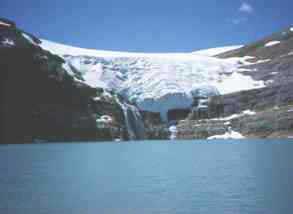 Alberta's WaterIntroductionPublications Climate Change Industrial Impacts Agricultural Impacts Urban Impacts Biodiversity Loss Definitions Links Site Map |
 |
|
 |
| The Bow Glacier |
Data collection and fieldwork spanned four consecutive years (1997-2000). This period included a strong ENSO (El Niņo Southern Oscillation) cycle, so the data set provides a unique opportunity to examine the hydrological regimes of the glacial and non-glacial streams, and their influence on stream OC budgets under contrasting hydroclimatological conditions.
The results of this research indicate that there are many aspects of glacial catchments that will enhance the delivery of OCs to the lake via runoff, relative to non-glacial environments. A combination of low forest and soil cover in the glacial catchment, and lower dissolved organic carbon (DOC) concentrations in runoff likely contribute to high deposition, efficient delivery, and high bioavailability of OCs in glacial runoff. The presence of forests appears to reduce the total accumulation of OCs (and snow) relative to barren/sparsely vegetated areas. Thus, the lack of/limited forest cover in glacial catchments may contribute to higher OC deposition in glacial catchments relative to environments with more forest cover. DOC and solute chemistry indicate that there is likely lower retention of OC contaminants in glacial catchments due to the limited presence of organic soils and vegetation, and the limited contact between glacial runoff and these sources of organic carbon. The lower DOC concentrations and less aromatic nature of DOC in glacial runoff could enhance the bioavailability of OC contaminants relative to snowmelt fed catchments where the flushing of soils during snowmelt provides higher concentrations of more aromatic DOC. High contributions of OCs from glacial runoff in years with extensive melt may result from multi-year storage of OCs in firn or glacier ice and/or from flushing of OCs stored within the firn aquifer during low ablation years.
Links
- Pesticides: U.S. Environmental Protection Agency
- Persistant Organic Pollutants: United Nations Environment Program
- Persistant Organic Pollutants: Center for International Environmental Law
- Arctic Monitoring and Assessment Program, dealing with contaminants in the arctic
- Melissa's Home Page



 Hydrological and hydrochemical investigations in a glacial lake catchment: implications for organochlorine transport
Hydrological and hydrochemical investigations in a glacial lake catchment: implications for organochlorine transport